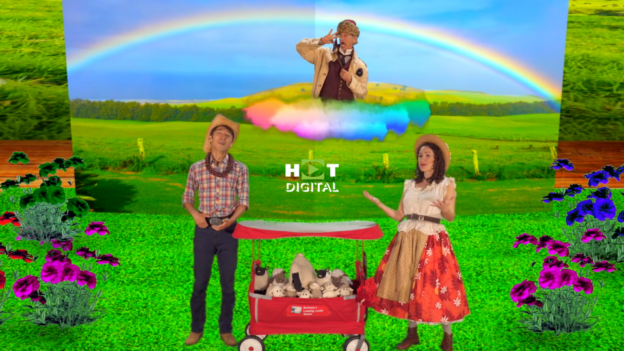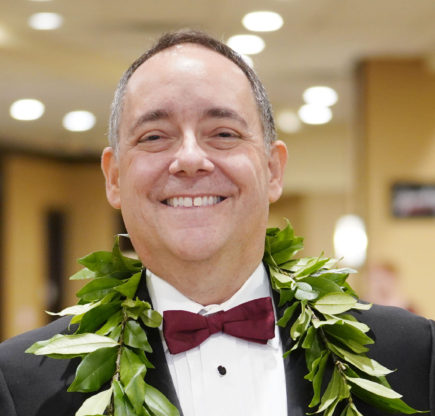
Bastien & Bastienne – Learn more with HOT’s Andrew Morgan
HOT General Director Andrew Morgan makes his directorial debut with the company in Mozart’s Bastien & Bastienne. Watch it now on HOT Digital.

The story of Bastien & Bastienne is a simple one: two young lovers are having a spat and reconcile with the help of a trusted, if a bit eccentric, adviser.
Several aspects of Mozart’s charming little opera stood out to me and inspired the direction I took. Especially since it was written by a twelve-year-old, I wanted the production to appeal to younger audiences while still engaging adults.
That’s right! Mozart composed the piece when he was only twelve! That is an extraordinary achievement at any age, really, but as a child prodigy, it was hardly his first accomplishment… He was playing minuets on a keyboard by the age of four, touring Europe with his father and sister, composed short pieces by five, and wrote a symphony by the age of eight. So why not an opera at twelve? It is simple in style, but elegantly shows the promise of compositional talents that became fully realized in his adulthood.
Bastien & Bastienne is made up of sixteen short pieces – most are only two minutes long, and with only one singer performing at a time – so it lent itself well to capturing on video in a safe manner.
It is a parody of a musical entertainment popular in Mozart’s youth called a Pastoral, dramatic works that featured shepherds and nymphs frolicking in nature. So, the character Bastienne is a shepherdess.
The piece lent itself to a fantastic, fairytale look and feel in its telling, including having a visual element of pages being turned in a storybook. There are a lot of little touches, especially with the animation, so keep an eye out for that.
I knew immediately that I wanted to perform the piece in English, so we used a version created by Donald Pippin of Pocket Opera in San Francisco – a wonderful gentleman and company I worked with for over twenty years as both singer and stage director.
The original version, in German, included short spoken dialogue woven in between those short arias – a compositional style known as “singspiel” (which literally translates to “sing play”). Pippin replaces the dialogue with narration.
For the narrator, I wanted an actual character, rather than a disembodied voice. Keeping with the family-friendly feel, a hand-puppet that could be an animal on Bastienne’s ranch seemed like the right choice, so we created Sam the Sheepdog!
The magical character, Colas – delightfully portrayed by our own Jamie Offenbach – also spoke to the fantastical. [Note: you’ll want to watch the production at least twice so on one viewing you can focus on Jamie Offenbach’s hysterical facial expressions as he “listens” to Bastien and Bastienne pouring out their hearts to him. Priceless stuff!]
Having visited the Big Island several times during past travels to Hawaiʻi, I immediately latched onto the idea of setting the action on one of those beautiful, sprawling ranches. In doing a bit of research, I came across gorgeous photos of Kahua Ranch in Kamuela and we were fortunate enough to be able to secure their use.
I adore Mozart and have directed – and sung in – many of his operas. So that fact right out of the gate made it fun. But this work was new to me, which added to my excitement. And of course, the unique nature of creating something for film was amazing. There are elements that are the same as for live opera – costumes, singers, props, sets – but there’s also so much more. We filmed in front of a green screen, so that means the sky is the limit (of course, limitation of resources – time and money – are still very much real) in being creative.
With a live production, your goal is to tell the story in a linear way. You start rehearsing in very small segments, starting and stopping a lot and continually make adjustments. But once you get everything up and running, rehearsals start at the top of the opera and run to the very end, with no stopping. Your focus is always on the big picture, and what the show looks like from ten rows back in the theatre.
For digital – at least for how I approached this project – it was completely backwards. I started working through the show top to bottom, with as few stops as possible, so we all had a sense of the flow from scene to scene. But for the “performances” – the video shoots – each piece was shot individually and multiple times with cameras focusing on different angles. Then you add in patches on top of that – close-ups and outtakes that are then edited into the final version to provide visual interest.
That vision was realized beyond my wildest dreams thanks to the creativity and hard work of our Director of Photography and Editor David Hunt. He has truly created a unique world for our telling of this opera!
I hope you’ll enjoy the magic that only digital can provide, including animation (also created by David!) creating the fantastical look and feel you’ll see in this video.
